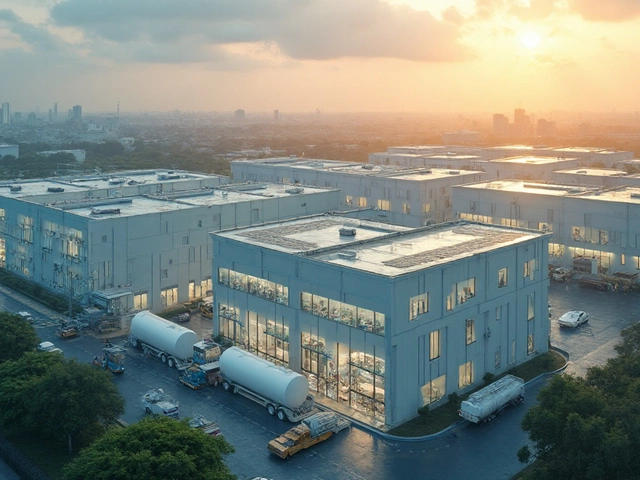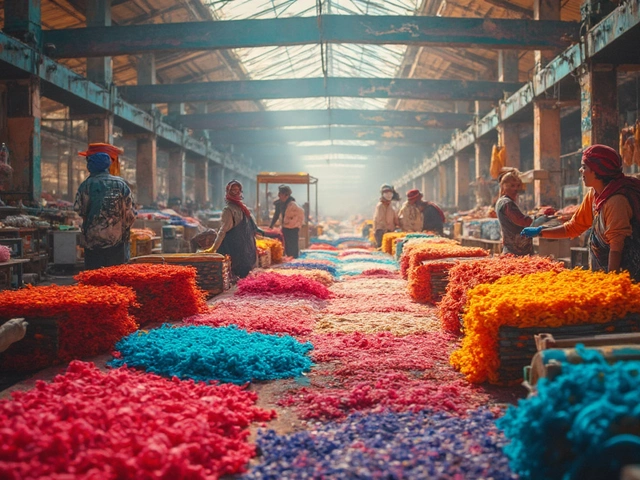Profit margin is the number that separates hobbyists from serious small business owners. Let's be straight: it doesn't matter how much you sell if your costs eat up everything. That's why picking a manufacturing business with high profit margins is a smart move, especially if you don't have a huge budget to waste on trial and error.
Some manufacturing ideas stand out because they don't need a massive factory, loads of employees, or piles of raw materials to get started. We're talking about businesses like making specialty soaps, 3D-printed items, or custom jewelry. The fun part? You can set up many of these from your garage, spare room, or even the corner of your living room.
The big edge with these businesses comes from selling customized or premium products. People will pay more for something unique or tailored to their taste—way more than what it costs you to make it. That means more profit in your pocket and less stress about keeping up with giant manufacturers or crazy retail chains.
- Why Profit Margin Matters in Manufacturing
- Top High-Margin Manufacturing Niches
- Real Examples: What Do These Businesses Look Like?
- Costs, Risks, and Smart Ways to Boost Margins
- Tips for Getting Started With Less Stress
Why Profit Margin Matters in Manufacturing
If you’re thinking of jumping into a small manufacturing business, the first thing you need to care about is profit margin. This is the money you actually keep after covering all those annoying expenses—materials, tools, labor, bills, and the rest. It sounds obvious, but a lot of people chase sales and ignore the small number that shows what’s actually left at the end of the day.
Here’s the bottom line: a high profit margin gives you more breathing room. If costs jump, your profit doesn’t disappear. You can recover from mistakes or slow months a lot easier. Plus, the extra cash makes it way simpler to upgrade equipment, launch new products, or just pay yourself more. Nobody wants to work all year and have nothing to show for it.
If you compare manufacturing to other fields, it’s clear how much the numbers can swing. For example, according to a 2024 report from IBISWorld, average profit margins across all small manufacturers range from 4% to 12%. But pick a niche like specialty foods or custom 3D printing, and that margin can shoot up to 25-50%... That’s a huge difference in what you actually take home.
| Manufacturing Type | Average Profit Margin (2024) |
|---|---|
| Standard Metal Fabrication | 6% |
| Commercial Printing | 8% |
| Specialty Food Manufacturing | 27% |
| Custom 3D Printing | 38% |
| Artisan Soap & Cosmetics | 42% |
So how do you figure out your own margin? Just do this quick math: Measure your total revenue (everything you sold). Subtract all your direct costs (materials, packaging, small tools, direct labor) and your regular business costs (electricity, rent, marketing). Divide what’s left by the total revenue. That’s your real profit margin, not just a guess.
One more thing: investors, banks, and even suppliers look at your profit margin before offering help or credit. If they see you’re running a business with thin profits, they’re less likely to trust you. When you lead with a profit margin that beats the average, you look like you know what you’re doing.
Top High-Margin Manufacturing Niches
When you're looking for manufacturing businesses with the best profit margins, you want to focus on products that don't cost much to make but can sell for a solid price. Here are some of the most reliable picks in 2025:
- Specialty food products (like gourmet jams, sauces, organic snacks): These are trendy and can have profit margins above 50% if you keep packaging simple and sell direct or online.
- 3D printing custom items: You can make everything from replacement parts to home décor or business promo products. Materials are cheap, and customers pay for personalization.
- Handcrafted soaps and beauty products: People love small-batch, natural ingredients, and the markup can go as high as 70% per bar or bottle, especially if you sell online or at local markets.
- Eco-friendly home goods: Think reusable kitchen products, beeswax wraps, or bamboo toothbrushes. These ride the sustainability wave and fetch high markups at eco shops and online.
- Custom apparel and printing: T-shirts, hats, and bags with unique designs or local flair. With print-on-demand tech, you avoid holding inventory and pay only when you sell.
To give you a quick snapshot, here's how typical profit margins stack up:
| Business Type | Typical Profit Margin (%) | Startup Cost (USD) |
|---|---|---|
| 3D Printed Products | 55-70 | 2,000 - 8,000 |
| Specialty Food (Snack/Jams) | 45-65 | 1,500 - 6,000 |
| Handmade Soaps/Beauty | 60-75 | 750 - 3,500 |
| Eco-Friendly Home Goods | 50-68 | 900 - 4,500 |
| Custom Apparel/Printing | 40-55 | 1,000 - 5,000 |
These numbers aren't wishful thinking. For example, in 2024, small soap makers using direct-to-consumer sales channels reported profit margins from 65% up, according to a Shopify business survey. And independent 3D print shops are popping up everywhere, thanks to machines and supplies getting cheaper every year. The real winners? Folks who cut out the middlemen and sell directly to customers.

Real Examples: What Do These Businesses Look Like?
Want real-life proof? Let's walk through some small manufacturing shops that are actually crushing it when it comes to profit margin. We're not talking about massive plants—just focused, clever setups running in cities and suburbs across the world.
First up, check out custom soap makers. A lot of these businesses run from home workshops, selling online and at local markets. It costs less than $2 to make a bar of specialty soap, but it usually sells for $6 to $10. That's a margin most retail shops can only dream about. No wonder the handmade soap market in the US alone cleared $2.8 billion last year.
Next, think about 3D printing. Companies and hobbyists use basic 3D printers to produce things like custom phone stands, small replacement parts, or even mini figurines. The initial printer setup can set you back a grand or two, but the per-item material cost is often under $1. People pay $10, $20, or more for a single printed part—especially if it solves a problem you can't fix with something off the shelf.
Jewelry is another winner. Even with modest metal and bead costs, custom or personalized necklaces can sell north of $50. One owner told Business Insider,
"I started on Etsy with $200 in supplies. Within six months of focused marketing, I cleared $18,000 in profit with just my kitchen table as a workspace."
If you're wondering how these businesses really stack up, take a look:
| Business Type | Startup Cost | Materials Cost (per unit) | Typical Selling Price | Profit Margin |
|---|---|---|---|---|
| Handmade Soap | $500 - $2,000 | $1.50 | $7.00 | ~78% |
| Custom Jewelry | $400 - $1,500 | $8.00 | $50.00 | ~84% |
| 3D Printed Goods | $1,000 - $3,000 | $1.00 | $15.00 | ~93% |
The numbers don't lie—if you're after a profit margin that actually pays off, these businesses deliver. What do they have in common? They all focus on niches, small batch runs, and direct-to-customer sales. That means less waste, better prices, and way more control.
Costs, Risks, and Smart Ways to Boost Margins
Let’s talk numbers—the good, the ugly, and the game-changers. No matter how clever your product is, high costs eat into your profit margin fast. In manufacturing businesses, costs break down into three usual suspects: raw materials, labor, and overhead (rent, utilities, equipment).
For example, homemade candle makers spend about 30%-40% of their revenue on just wax, fragrances, and wicks, according to a survey by the National Candle Association. 3D printing shops, on the other hand, spend much less on materials, but their biggest bills are for the printer itself and regular maintenance.
| Expense Type | Average % of Income (Small Operations) |
|---|---|
| Raw Materials | 25-40% |
| Labor (Including Own Time) | 20-35% |
| Overhead | 10-20% |
Here’s a blunt truth: risk comes with the territory. Prices for materials can spike overnight, machines can break down, and customer tastes can shift without warning. That being said, businesses selling personalized goods usually stay safer because buyers care less about price and more about what they’re getting.
"Small manufacturers who keep their products unique and manage inventory tightly often see margins above 50%. It’s about control, not scale." — Robert Owens, Small Business Manufacturing Institute
If you want to keep risks down and profits up, try these straightforward moves:
- Buy materials in bulk when you can, but avoid overbuying stuff that might expire or go out of style.
- Keep your product line lean, especially at the start. Too many SKUs mean more leftover stock and more headaches.
- Outsource tasks like packaging or shipping before you feel overwhelmed. Your time has value, too.
- Automate things like order tracking, label printing, or even marketing emails to save dozens of hours a month.
One last tip: always watch your prices. Raising them just 5% can sometimes boost your bottom line a whole lot more than chasing extra sales—especially in the niches where customers already expect to pay more for small-batch or custom work.

Tips for Getting Started With Less Stress
Jumping into a new manufacturing business sounds overwhelming, but small, smart moves make everything easier. The truth is, you don’t need to go all-in on day one. Here's how to keep your stress low and your odds of success high—while protecting your profit margin from day one.
- Start simple and scale smart. Don’t blow your budget on fancy equipment you may not need. Many custom product makers start with secondhand gear from online marketplaces or even rent machines locally. Start with just enough to test your market.
- Watch your input costs like a hawk. Small changes—like buying raw materials in bulk or partnering with other makers to split costs—can mean the difference between making and losing money. A Soap Makers’ Guild survey found that solo crafters lowered costs by 22% just by ordering lye as a group.
- Keep your workspace lean and legal. You don’t need a big warehouse. Many small manufacturers launch from a spare room, garage, or shed. Just check zoning rules and get any permits your city requires, especially for food or health-related products.
- Market with real proof. Collect customer reviews and show before-and-after photos of your work. Potential buyers want to see results, not just promises. Social media is your best friend when you’ve got a story and some visuals—look at how small 3D printing shops rack up hundreds of orders from a single viral post.
- Automate what you hate. Burnout kills more small businesses than competition does. Invest in simple automation for repetitive tasks—like inventory tracking, basic accounting, or automatic emails—so you can focus on actually making and selling your product.
Here’s a quick look at some real startup costs and break-even numbers for popular small manufacturing niches in 2024, so you know what you’re getting into:
| Business Type | Startup Cost (USD) | Typical Gross Margin | Avg. Time to Break Even |
|---|---|---|---|
| Specialty Soaps | $1,500 - $4,000 | 50% - 60% | 4-6 months |
| 3D Printing | $2,500 - $8,000 | 60% - 75% | 3-8 months |
| Custom Jewelry | $1,000 - $3,500 | 60% - 80% | 2-6 months |
It’s normal to feel like you’re winging it at first. But if you keep your costs tight, focus on a single product or niche, and automate wherever possible, you’ll feel less pressure and see more profit—fast. The main thing? Stick to your numbers and don’t let excitement cloud your choices. Businesses with the fattest margins always keep it real with the math.






